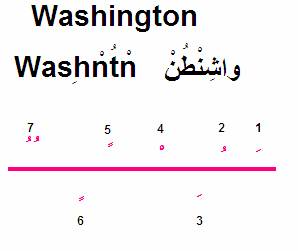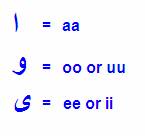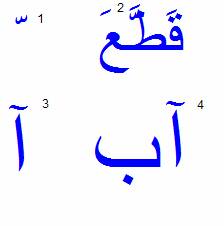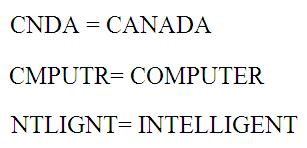|
|
Learn Arabic Online /
اللغة العربية
Arabic Vowels
Short Vowels in Arabic:
In
Arabic short vowels are not a part of
the Arabic alphabet, instead they are written as marks over or below the
consonant and sometimes over or below a long vowel. To make it easy we will
take an example in English: the word Canada is written as CNDA but using
Arabic Alphabet, the vowel A between C and N and between N and D are
omitted, instead they�re replaced by small symbols, especially because
they�re only short vowels, you see the little dashes on the top of C and on
the top of N in the image below, they�re called FATHA in Arabic, meaning the
short vowel �A� in English, so instead of writing a word full of vowels in
Arabic, we only write the FATHA on the top of a consonant to indicate a
short vowel �A�, and also we have symbols referring to short vowel �E� or
�I� , and also a symbol for short vowel �O� , actually this is a good idea,
because it�s saving space and also has an other advantage that we will see
later.
You may have noticed that the consonant D and the vowel A don�t have any
symbols on the top of them in the image below, that�s because the �A� at the
end is considered a long vowel in this word, so it�s the vowel of �D�, no
need to add another vowel on the top of �D� since the long vowel �A� is
already helping us pronounce the word the right way. Now you can look at the
word Canada in Arabic; you will see that it has the exact symbols as the
word CNDA.

The table below shows other types of
symbols referring to Arabic short vowels. First we see Washington the way
it�s written in English, and then we can see it using English Alphabet but
Arabic symbols of short vowels. And finally you can see the word in Arabic
with its full short vowels.

�WA� as you noticed doesn�t need a symbol,
because the �W� is followed by a long vowel �A�, �SH� is not followed by a
vowel, which means that we need to add a short vowel referring to �i�, and
indeed we added one already, it�s the tick below the �SH� which is called
KASRAH, you can also see it marked as (#3). The �N� has a small circle on
the top of it, that symbol is called SUKOUN (marked as # 4 in the table
below) referring to a consonant without a vowel, So any time we have a
consonant that doesn�t have a vowel, we just add that small circle on the
top, note that the SUKOUN should always be placed on the top and never below
a consonant. So we used the Sukoun in this word because we didn�t say NA NO
NI but we just said N. Now let�s look at the T, it has a little symbol which
looks like comma on the top of the letter, that symbol is called DAMMAH (# 2
in the table above) referring to a short vowel �O� , so when we add DAMMAH
to the letter �T�, we will get �TO�, easy, isn�t it! And finally as we have
seen before, the final N has another SUKOUN meaning that the N is without a
Vowel, and should be pronounced N full stop.
Let�s review what we just went through.
1 = FATHA = Short Vowel �A�
2 = DAMMAH = Short Vowel �O� or �U�
3 = KASRAH = Short Vowel �I� or �E�
4 = SUKOUN = Used for consonants lacking a
vowel after them.
5= FATHATAIN= double FATHA (FATHA on the
top of another FATHA)= FATHA + N= the short vowel �A�+ N:
Ghadan = غداً = Tomorrow
6= KASRATAIN= double KASRAH (KASRAH on the
top of another KASRAH)= KASRAH+ N= the short vowel �i� or �e�+ N:
Kuratin= كرةٍ =a ball
7= DAMMATAIN= double DAMMAH (DAMMAH next to
another DAMMAH)= DAMMAH+ N= the short vowel �o� or �u�+ N:
Kitabun= كتابٌ= a book
Note that # 5, 6, 7 are
not used as much as 1-4, also note that # 5, 6, 7 are only used at the end
of a word
Long Vowels in Arabic:
The table below shows the long vowels in Arabic, they�re considered long
vowels because of the stress they put on a given vowel, same thing exists in
English, the word �exceed� should be stressed
in the vowels �ee� or �loose� the stress in the
�oo�, note that these long vowels are also considered some sort of
consonants ( their pronunciation as a consonant can be found on the page�
ARABIC ALPHABET�.

There is also the SHADDAH, it�s the symbol
marked as number 1 on the image below, used when we have a double consonant,
like instead of writing the proper name (ANNA with double �N�, we only write
it with one N and add SHADDAH on the top of N, the example # 2 shows how
the SHADDAH placed on the top of the letter T in Arabic, the transliteration
of the word is QATTA�A which mean the verb �to cut� in Arabic it�s written
QATA�A and instead of writing double T, the word has only one T and a SHADAH
on the top of it.
Example # 3 shows a little symbol on the
top of the ALIF which looks like the Latin ~, it�s called MAD, and mostly
used on the top of ALIF to express a long �A� something like �AA�, the word
shown in example # 4 is AAB, it means the month of August, but the MAD is
not used that often, so you will come across it but rarely.

Finally, This may surprise you but short
vowels in Arabic are not used that often, you may come across them if two
words look the same and the writer wants you to distinguish between them so
that they won�t be confused, the person would than add only the vowel which
doesn�t exist in the other word, but other than that sometimes you can read
a whole text without coming across any short vowel. The reason is that in
Arabic most words are distinctive without short vowels; I will give you an
example in English in the Image below:

It doesn�t take that much thinking to know
what do these words mean, I omitted 2 vowels from Canada for example, and
two vowels from the word Computer ... that�s how reading Arabic works.
Sometimes we have to add a vowel because it�s a long vowel and not a short
one like the �a� in Cnda.
Below is an example of how the verb �to
write� is written in Arabic, it�s written كتب which
is equal to �ktb� in Latin alphabet, but we don�t read it like �ktb� but as
�kataba�, as you have noticed 3 vowels are added when you pronounce it, but
when you write it, only the consonants are enough to give us an idea about
the word. Writing only one verb in Arabic alphabet without short vowels
saved you the time to write 3 vowels, imagine how much it could save you
when you write a text�

In short, short vowels that are presented
as symbols are not important to read Arabic, but they make it easy to read
for beginner and also to avoid confusion between two similar looking words.
Try to master these Arabic vowels as
they�re very important for beginners.
www.worldofislam.info
|